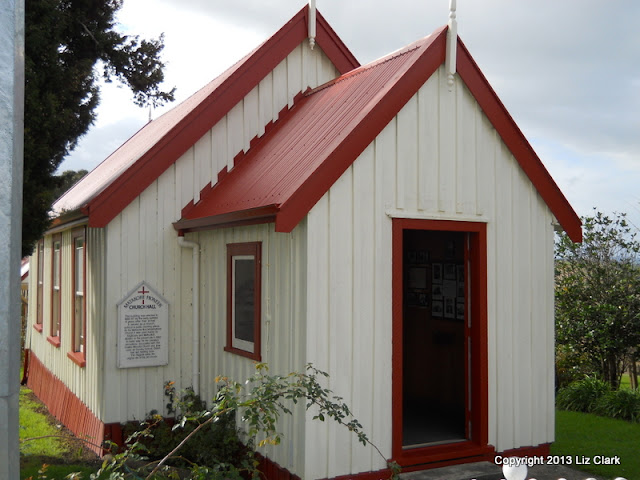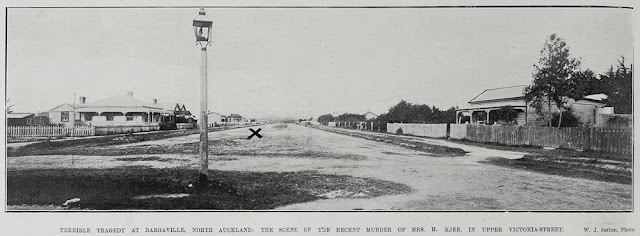Matakohe's first church
The Kauri Museum at Matakohe, should be rightly proud of its beautifully restored Kauri lined and constructed pioneer church situation on Church Road just opposite the museum site. This building is listed on the register of the NZ Historic Places Trust as a Category 2 Historic place. Registration No: 3905. I visited the museum recently and decided to look a bit more indepth into the building's origins.
The small kauri church situated at Church Street, Matakohe
was constructed in the year 1868, by its architect and builder Samuel Cooksey.
The building was officially opened on Christmas Day (25 December) 1868, with
Reverend Thomas Booker presiding over the first service held in the building.
“Christmas Day witnessed the inauguration of a new era in the history
of this settlement—the opening of its first church. The building, designed and
erected by Mr S. Cooksey, reflects great credit upon him, and the energy of the
settlers. Being completed, the day was considered appropriate for its formal
dedication to the worship of God.”
New Zealand Herald, 31 December 1868
The New Zealand Herald
article also noted the debt free status of the new church built with funds
raised by subscription from the local community. A new fence was yet to be
built around the exterior of the building, and further funds were required to
complete the project.
Earlier in 1868, a need for a suitable building was realised
when Sunday school classes, religious services and school lessons were being
held in the home of one of the settlers.
An initial meeting of settlers was held on 19th February
1868, where it was determined to build a congregational church, and for it to
be available during the week for secular education. Cooksey soon fulfilled this
need with the construction of the longed for building to fulfil the purposes
outlined at the February 1868 meeting.
The first year anniversary service was celebrated in the
church on Sunday 19th of December 1869, with two services held and
the sermon provided by Reverend Booker to celebrate the day. The next day a
meeting was held at Samuel Cooksey’s building, with various topics discussed.
“On the following day a social meeting was held in Mr. Cooksey's
building, which was most tastefully decorated with evergreens; conspicuous
among which were the fern tree and cabbage palm, most appropriate ornaments for
bush gatherings. The weather in the earlier part of the day was very rough,
preventing many friends from Paparoa and elsewhere, who would otherwise have
been present, from assembling on the occasion. A goodly company, however,
appeared to do justice to the good cheer, provided kindly and gratuitously by
the ladies in the neighbourhood. The public meeting in the evening was presided
over by the Rev. T. Booker, who kept alive the interest of the meeting by his
pertinent observations on the various topics referred to by the speakers.”
New Zealand Herald, 31
December 1869
In an 1871 report to the Congregational Home Mission
meeting, it was noted on the Kaipara District
“In the Kaipara the agent of the church reported favourably of the
disposition of the people to aid the minister. An itinerating cottage service
had been established. They had here a handsome church, a harmonium, bell, and
other church furniture, all of which had been paid for. He recommended to the
consideration of the committee the necessity of appointing a suitable minister
for the western portion of the district. Matakohe had a fortnightly
visitation.”
New Zealand Herald, 26
May 1871
During November of 1872, a request was made to redecorate
the interior of the church. At the meeting, held on November 13, however, it
was advised there no funds on hand to do so. White washing the walls, it was
noted, were the preferred option, however until the ownership of the building
could be ascertained, no upgrading of the interior could be undertaken. The
allotment of land the church stood upon, had been gazetted as being vested to
the Education Department
“As there were no funds in hand, it was thought that whitewashing would
be most appropriate, but even that could not be proceeded with till it was
known to whom the building belonged as, though built by public subscription,
the ground has not yet been conveyed to the trustees by the Superintendent, and
the allotment has been gazetted as belonging to the Central Board of Education
pro tem. It was therefore resolved that a public meeting be held on or about
that day month to receive report of trustees, who could not give the necessary
information till then.”
Daily Southern Cross, 18
November 1872
In December of the same year, a meeting was held with a
resolution to have a delegation of three members consisting of Isbister, Rees
and Sykes to make enquiries regarding the purchase of the land on which the
church stood upon.
By 1875, two half time schools were in the district under
the care of Mr A. Fisher. The church building continued during the week to be
used for secular educational purposes. Services were being held each Sunday,
with Sunday school classes taken by Miss Fisher. Reverend William Gittos made
occasional visits to the congregation.
On March 18th, 1878, a tea meeting was held for
the benefit of the Wesleyan society. A contemporary report of the time refers
to the building as ‘the chapel’. A trust deed for the building created at the
time of its inception allowed for services by all denominations. Miss Fisher
was noted as playing the harmonium. The meeting was attended by 100 people who
sat down to eat in the church. Reverend William Gittos was noted as one of
those attending.
A total of £8 had been
raised from the meeting for the benefit of the Wesleyan Society. Previously, at
an earlier meeting in late February, reported to the New Zealand Herald that it had been found that the chapel was
inadequate to hold large public gatherings. The need for a new public hall had
been mooted. Reverend William Gould had attended the April meeting.
February of 1880, saw a visit from Bishop Cowie who held a
divine service to a large attending congregation. The report of the time noted
the conversion of 13 or 14 local Maori to Christianity.
Sources
Daily Southern Cross, Volume XXVIII, Issue 4753, 18 November
1872, Page 2
Daily Southern Cross, Volume XXVIII, Issue 4783, 24 December
1872, Page 2
Daily Southern Cross, Volume XXXII, Issue 5776, 1 April
1876, Page 3
New Zealand Herald, Volume IV, Issue 1034, 8 March 1867,
Page 6
New Zealand Herald, Volume VI, Issue 1591, 31 December 1868,
Page 4
New Zealand Herald, Volume VIII, Issue 2288, 26 May 1871,
Page 3
New Zealand Herald, Volume XV, Issue 5083, 2 March 1878,
Page 1
New Zealand Herald, Volume XV, Issue 5107, 30 March 1878,
Page 3
New Zealand Herald, Volume XVII, Issue 5702, 26 February
1880, Page 3






Comments